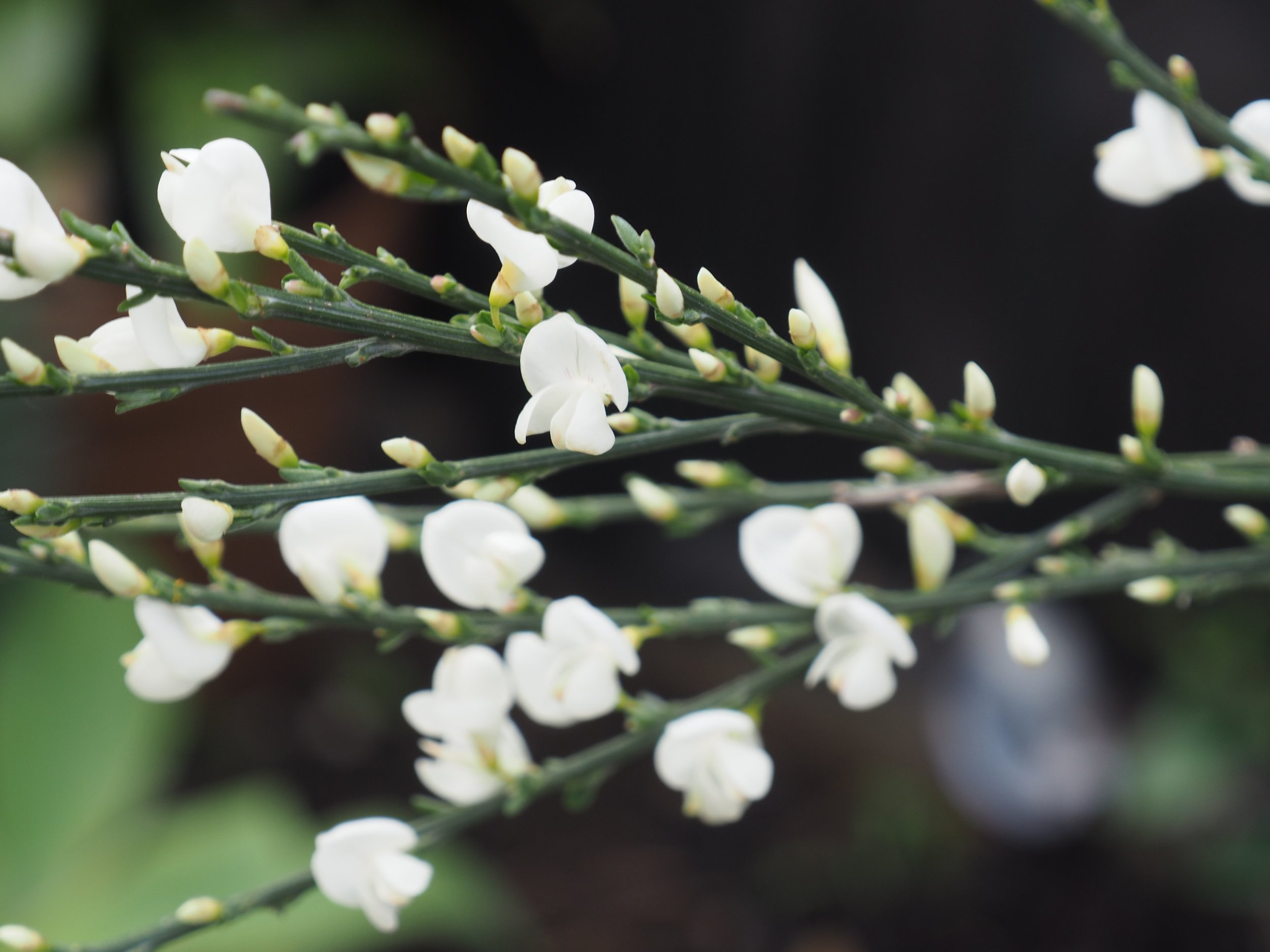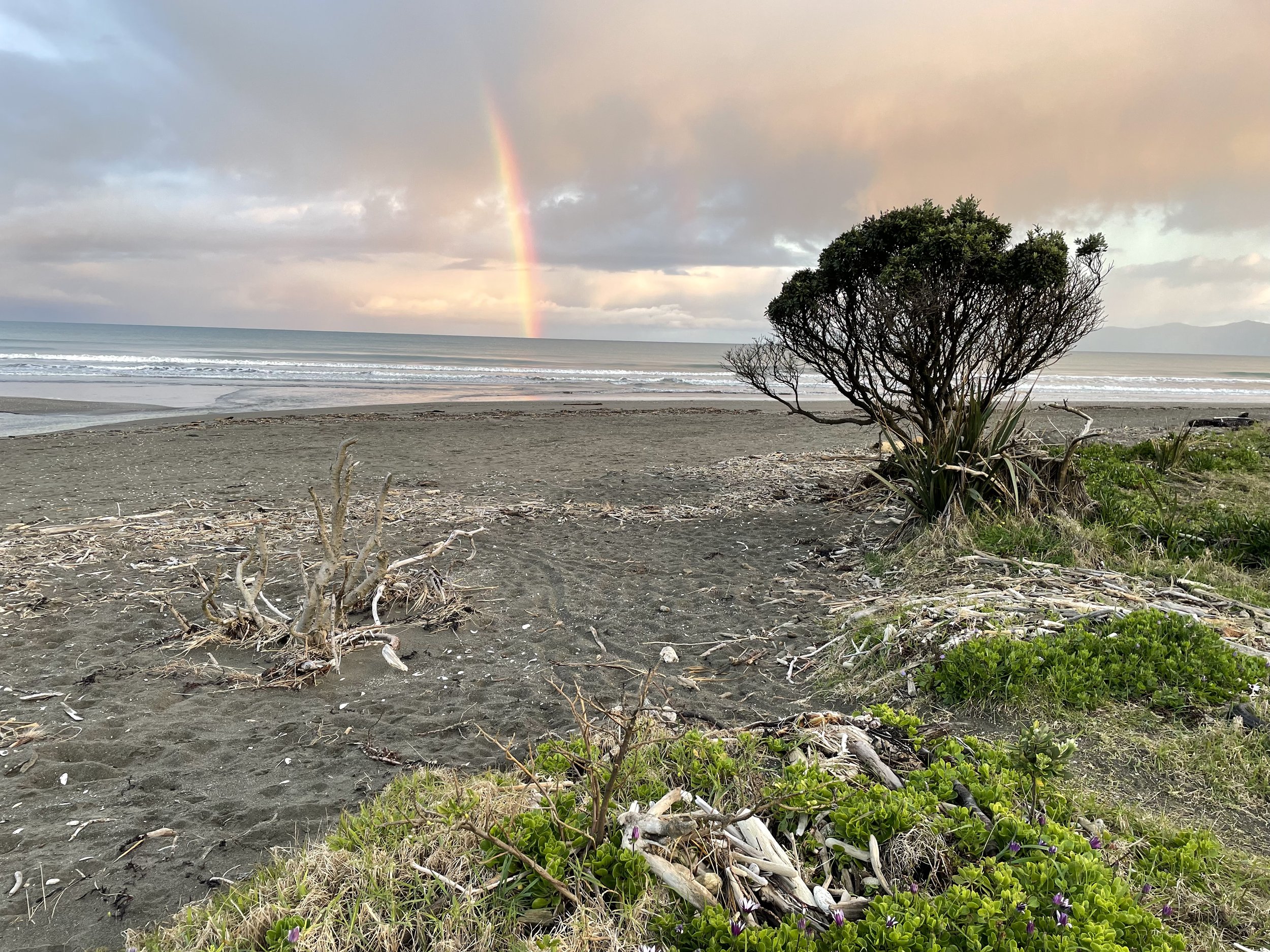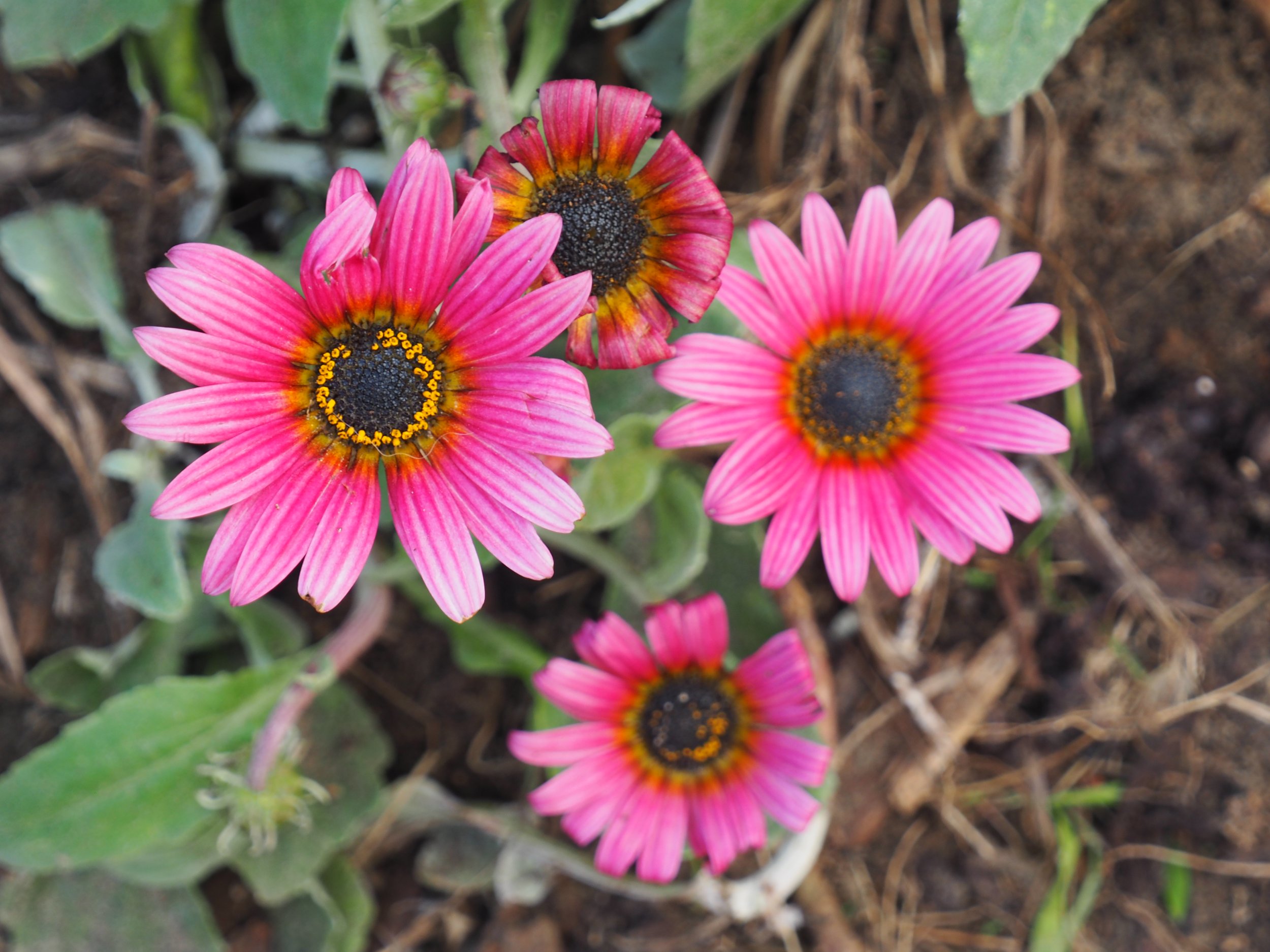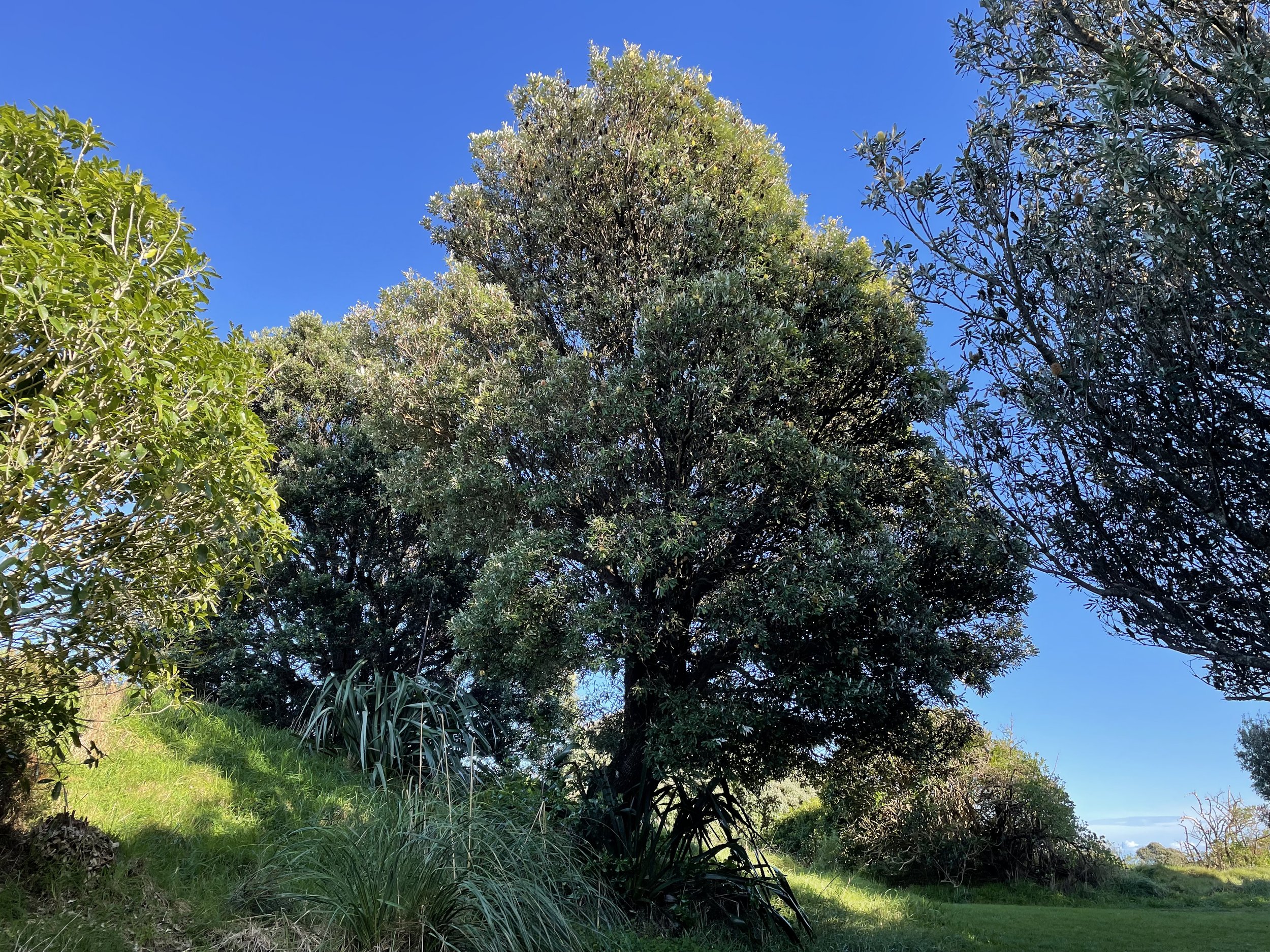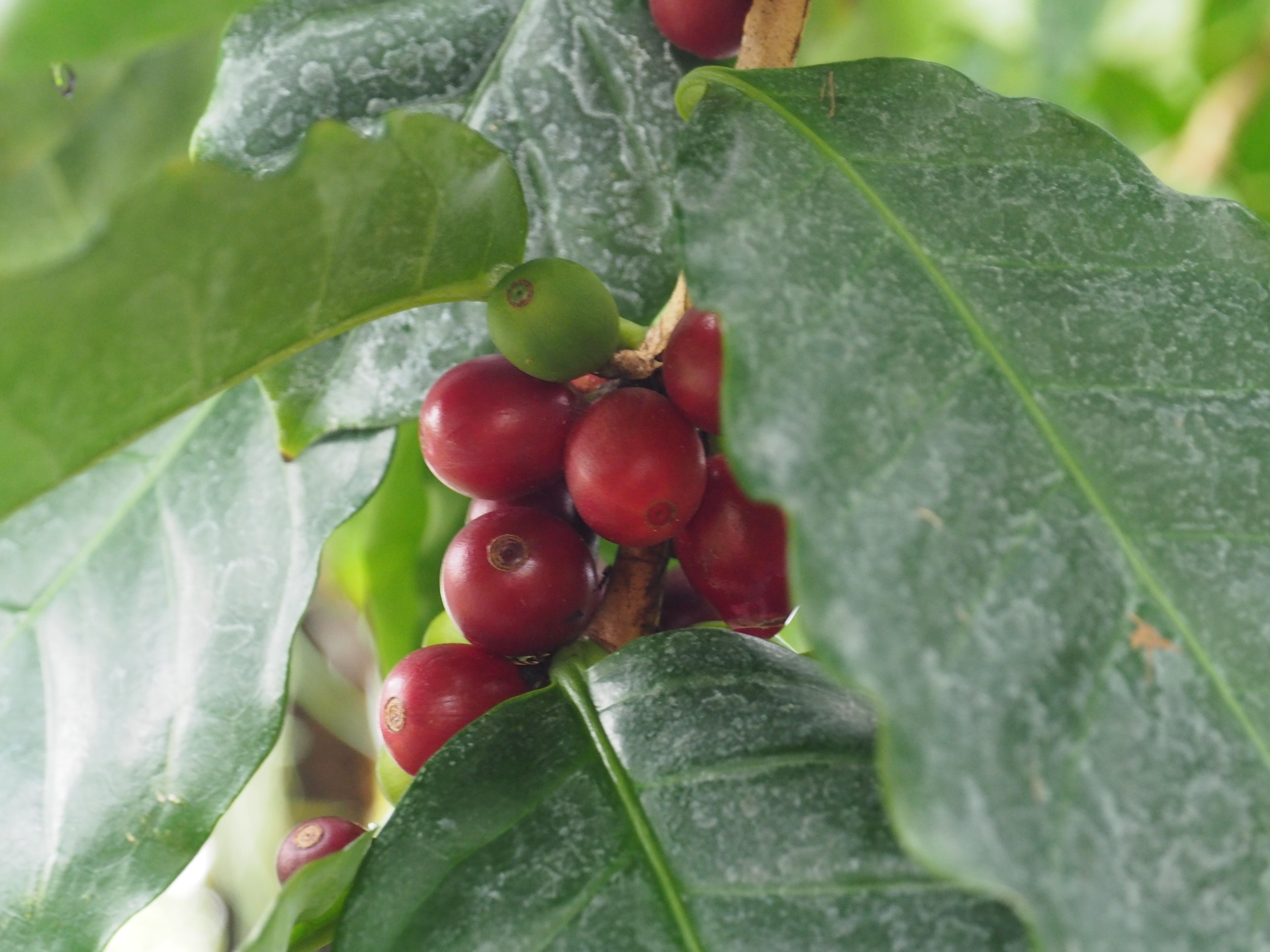The Queen has died.
If she were a tree then she’d be an oak. A majestic old oak. The common oak is my favourite tree, Quercus robur, an English native. You often see them in parks standing alone. So full of grace and character and beauty. Steadfast. Changing with the seasons and age, but constant. An old oak speaks of longevity, and patience and wisdom.
My nana was our family’s queen. She too was 96 when she died. She was our steadfast glorious oak, which we gathered under.
This afternoon I went for a short stroll in Queen Elizabeth Park. I passed a meeting of the Wellington Welsh Corgi Club. They were being filmed by One News. Then I strolled across my favourite bridge and noticed that someone had tied a bouquet to the railing, A yellow lily and olive branches.
Queen Elizabeth Park, Paekakariki.
I heard about a different sort of tree this week. Some people call it the loneliest tree in the world. The Guinness Book of Records classify it as ‘the most remote tree in the world’. It’s a sitka spruce that was planted over a hundred years ago on Campbell Island. Campbell Island is a subantarctic island 700km south of New Zealand. It’s the only tree in a cold and windswept place. It looks like a giant shrub thanks to its top being cut off and being used as a Christmas tree.
Here’s another lonely tree. It’s a pohutukawa on the edge of the beach at Paekakariki. It had a companion but it fell over after a storm. The sea sucked out all the sand around its roots. Then another storm came along and washed it away. I don’t think this pōhutukawa will be standing in a years time. I hope I’m wrong. We’ve had a lot of storms this year.
The lonely pōhutukawa tree.
It’s that breakneck-speed season. Spring. It’s hot, it’s cold, It’s still, it’s muggy, it’s raining or sleeting, or it’s blowing a gale from every which way. The sun has moved in the sky. There’s more of it and it shines for longer. Although it hasn’t really moved, It’s us who’ve moved. The earth is spinning 1000 miles per hour. An imperceptible speed. Unlike spring, which changes in a blink.
This week I tidied the greenhouse. I sowed seeds. Lots and lots of seeds.
Heirloom courgette seedlings.
I visited my friend Sophie. She gave me a fig tree. I’m going to get my husband to repot it into a grow bag.
On Wednesday I felt great. Completely better. So good I dug holes, planted plants and moved pavers in the new garden (and lots of easy tasks like threading wire along the fence). After all, I told myself, it’s a good test. If I feel great on Thursday I can get back to teaching. On Thursday, Friday, Saturday and Sunday I felt pretty awful. Two steps forward. One-and-a-half back. Long bloody covid.
The new garden is slowly taking shape. I will plant it up (leaving a path through it), cover the weeds and bare ground with cardboard and put a thick layer of mulch on top of that. My secret weapon against the dogs will be oioi, Apodasmia similis, jointed wire rush. It’s a beautiful tough plant that I’ll use to shield and protect the delicate ones. I need to buy it, lots of it, at one of those garden centres where they carry things to the car for you.
This garden will take longer to make than I’d planned. Good things take time, is what I tell myself. But try telling that to spring.
The new garden.
I’ve planted 5 Tecomanthe speciosa along the fence. I bought them for half-price along with 3 Helleborus ‘Ice Queen’ plants and an asplenium ‘Japanese Birds Nest Fern’.
My neighbour Caroline showed me her tecomanthes on Friday. Hers are growing along a fence in a sheltered sunny spot. Hers are large and lush and some are flowering. Mine are planted in a less protected place. I hope mine are going to be okay.
The new garden.
Tecomanthe speciosa, underplanted with a Helleborus ‘Ice Queen’, an asplenium ‘Japanese Birds Nest Fern’ and an agave.
Yesterday I underplanted the same tecomanthe with Crocosmia ‘Lady Hamilton’, Tulbaghia violacea and a blue pulmonaria.
Agave attenuata.
This agave is great in sun or shade.
I’m leaving all the existing plants where they are and planting around them.
Euphorbia melifera.
I grew Euphorbia melifera in my last garden. It has honey scented flowers and grows into a big bush. I think it will look great against the miniature flaxes behind it.
I bought some beautiful plants from Villaleigh Plants 2 weeks ago. They’re all going into the new garden. I’ve already planted a few. The dogs have stolen most of the wooden labels and eaten them.
Plants from Villaleigh Plants.
My white broom is flowering. It’s a shame that it’s blocked by the sacks of cocoa bean shells (which I’m going to use as a mulch - hopefully it doesn’t blow away or get eaten by the dogs).
On Saturday I went to the Paekakariki Book Fair and found some great gardening books.
Once I had them safely home I spent an hour in the sun admiring them. The pocket edition ‘Wild Flowers’ book has been used exactly as intended. Someone has recorded a date (usually 1970) and place (different places in Devon, UK) above a particular flower when spotted. The book on herbs (part of a series of books by Roger Phillips I’m collecting) is full of post-it labels on what dishes the herbs can be added to. The Christopher Lloyd book has a handmade birthday card for a grandma, filed between the pages. I love to find remnants of a books pervious life.
Two really nice things happened last week. A parking warden let me off a parking fine and I won a pair of secateurs from the Moths and Butterflies New Zealand Trust.
I read an article in their latest magazine (moths and butterflies that is) about swan plants. Apparently, lots of commercially grown swan plants aren’t grown organically. Insecticide and fungicide is sprayed on them while they’re growing in tunnel houses (or wherever they grow). When the monarch caterpillars eat the leaves they get poisoned. Moral of the story. Either grow your own swan plants or buy spray-free ones. I’ve planted 2 types of swan plants from seed…can’t wait to see the first green shoots.
The orchard garden.
There are are some changes in the orchard garden. I moved a native clematis from the side garden, which was getting burnt by salty winds. And I planted out my heirloom sweet pea seedlings. There are fat buds on my ponderosa lemon tree and small green shoots on my Black Doris plum. The daisies have woken up too.
A banksia tree.
The flowers on the banksia tree.
Tree of the week was going to be a banksia. Fittingly, it’s in Queen Elizabeth Park. Unfortunately I think it’s considered a pest tree. It was full of tui and bees when I walked past it yesterday. Apparently it outcompetes natives because of its prolific seed production and quick growth.
We need to remember that we clear-felled almost all the original forests and natural habitats in New Zealand. We permanently changed these habitats. No matter what we do and what we plant they will be different from before. The climate is changing too. We need to be openminded. We need to be pragmatic. The birds, bees, butterflies, moths and other worthy animals need food.
Over a hundred years ago a wasp called Pteromalus puparium was introduced to control the cabbage white butterfly, which is a pest for brassica growers. Now it in turn has become a pest. It lays its eggs inside butterfly and moth pupae. Killing them. An unintended consequence.
The government is looking at introducing another wasp into New Zealand. This is to control the spread of Acacia pycnantha, which is considered a pest tree, in coastal areas, for much the same reason as the banksia. The experts say that this wasp is a good wasp. I hope this small Australian wasp doesn’t have unintended consequences. Scientists only know what they know. There’s an awful lot of things they don’t know. They don’t know all there is to know about our endemic moths and butterflies and other beneficial insects.
Gorse used to be considered a pest plant in New Zealand. A noxious weed. It used to be poisoned and cut down and burnt. Now it’s been rebranded. Now it’s a nursery plant for natives. It puts nitrogen back into the soil. It stops water run-off. It stabilises hillsides. We now work with it and not against it.
Today I met my cousins for lunch at the Wellington Botanic Garden. We sat outside under the grape vines, which are still sticks. The roses were all fenced off until late spring, when they flower.
After lunch I wandered around in the hothouses with one of my cousins. My favourite part is the large pond with waterlilies. Some were in flower. The tiny iridescent fish darted about making tiny ripples in the green water. As I was leaving I saw this. Tree of the week. Coffea arabica. A coffee tree, complete with coffee bean fruits, or whatever the proper botanic name is. My cousin is a kindergarten teacher. She has a coffee tree growing at her centre. They will tolerate a temperate climate. Of course they love a hot humid climate best of all.
See you next Sunday.
